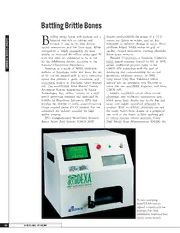
Battling Brittle Bones PDF
Preview Battling Brittle Bones
Battling Brittle Bones B uilding strong bones with exercise and a require one-hundredth the power of a CCD S F balanced diet rich in calcium and system, are lighter in weight, and are less F O N Vitamin D may be the best defense vulnerable to radiation damage in space. These PI —S against osteoporosis and low bone mass. While attributes helped NASA realize its goal of S FIT osteoporosis is largely preventable for most smaller, cheaper fabrications enabling affordable E N people, an estimated 44 million adults aged 50 future space missions. E B L years and older are considered to be at risk Photobit Corporation, a Pasadena, California- A CI for the debilitating disease, according to the based spinoff company formed by JPL in 1995, R E M National Osteoporosis Foundation. gained intellectual property rights to the M CO However, as a result of NASA know-how, CMOS APS technology with the goal of millions of Americans under and above the age developing and commercializing the second- of 50 can rest assured with an early assessment generation, solid-state sensors. In 1997, system that provides a quick, convenient, and Long Island City, New York-based Schick economical analysis to determine future fracture entered into an agreement with Photobit to risk. The accuDEXA® Bone Mineral Density create the new accuDEXA diagnostic tool using Assessment System, manufactured by Schick CMOS APS. Technologies, Inc., utilizes “camera on a chip” Schick’s accuDEXA system offers several sensor technology invented and developed by advantages over traditional osteoporosis tests, NASA’s Jet Propulsion Laboratory (JPL) that which assess bone density loss in the hip and matches the abilities of costly, power-consuming spine, and require specialized personnel to charge coupled device (CCD) cameras that are conduct. With accuDEXA, physicians can test considered the industry standard for high- the entire body’s bone density at a peripheral quality imaging. site, such as the finger, without applying gels JPL’s Complementary Metal-Oxide Semicon- or having patients remove garments. Using ductor Active Pixel Sensors (CMOS APS) Dual Energy X-ray Absorptiometry (DEXA), the Patients undergoing accuDEXA® tests are exposed to significantly less radiation than those submitted to traditional bone density testing methods. 66 HEALTH AND MEDICINE results are achieved in 30 seconds and printed dental radiography using up to 90-percent less S out in less than a minute, compared to the radiation exposure than conventional X-rays. F F O estimated examination time of 15 minutes for Called Computed Dental Radiography® (CDR), N PI hip and spine density analyses. the new digital imaging product utilizes an —S S Patients undergoing accuDEXA tests are electronic sensor in place of X-ray film to FIT E exposed to significantly less radiation (.0003 generate sharp and clear images that appear on N E µSv) than those submitted to traditional bone a computer screen within 3 seconds, and can L B A density testing methods (.1 µSv to 5.9 µSv). be enlarged and enhanced to identify problems. CI R E Effective radiation to the patient using Because CDR saves and stores the images, it M M accuDEXA is also just 1/150,000th of a chest eliminates costs incurred by film, processing, CO X-ray, according to Schick. The system detects and chemicals, and saves X-ray technicians and the smallest fluctuations in bone density with a other medical staff from waiting for develop- precision that has a less than 1-percent margin ment and duplication. The product is compat- of error. Additionally, accuDEXA’s cost-effective- ible with virtually all X-ray tubes, seamlessly ness and compact size make it possible for integrates with existing practice management physicians to offer the test to at-risk patients systems, and allows for the correction of within the confines of their own offices, underexposed radiographs. ❖ meaning that patients will not be inconve- nienced by having to travel to an off-site accuDEXA® and Computed Dental Radiography® are radiology location. registered trademarks of Schick Technologies, Inc. Schick also applied the CMOS APS technol- ogy to a new software product that performs Utilizing an electronic sensor, Computed Dental Radiography® delivers superior images instantly with no chemicals to handle, no hassles with duplicating images, and exposes patients to far less radiation than with film methods. HEALTH AND MEDICINE 67
